MEI - National Museum of Italian Emigration
Municipality of Genoa
- Municipality of Genoa
OUR SERVICES
- Multimedia set-up
- Exhibition Design
- Design / Manufacturing
- Brand Identity
- Digitization
- Interaction Design
- Cataloguing
- Interactive Installation
- Serious game / Gamification
- Web Development
- Video Production
- Content Production
- Virtual Tour
200 stories of emigration, 1300 archive images and original content accessible through 70 multimedia stations
16 rooms, 70 multimedia stations, 65 monitors, 25 laser projectors, more than 200 emigration stories and 1300 archive images. These are the figures of the New MEI – Museo Nazionale dell’Emigrazione Italiana (National Museum of Italian Emigration) at the Commenda di San Giovanni di Prè, a 12th-century Romanesque complex near the railway station of Genova Principe.
The MEI’s objective is not didactic or notional, but rather to offer suggestions through a few scenic elements in a neutral environment, with a view to recounting the identity of a city structurally linked to the phenomenon of migration. It was from Genoa that people left to reach the Americas, Africa, Asia and Australia, just as Piedmontese, Venetian, Sicilian, Neapolitan, etc. emigrants arrived in Genoa between the mid-19th century and the early 20th century, each with their own dialectal cadence so well reconstructed in the exhibition by the actors chosen from specific areas of Italy. In short, migration is a Genoese phenomenon but with a national and international scope.
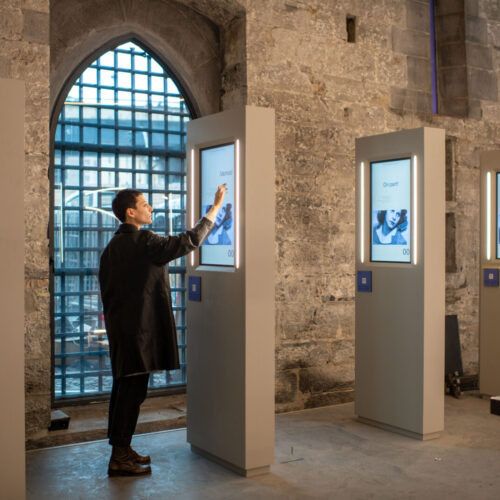

The setting up
The MEI set-up realised by ETT enhances a valuable archive heritage, to which are added original audio and video materials specially created for the multimedia stations. It was decided to use actors from specific areas of Italy (Piedmont, Veneto, Sicily, Naples) to preserve the exact regional focus and give the project a national flavour. Native speakers were involved where necessary: American, Argentinean, Portuguese, Belgian French and Swiss/German.
The style of the setting is contemporary, the reconstructions are not didactic, the aim is to give suggestions through a few scenic elements in a neutral environment. Similarly, for the filming, characters, costumes and photography are meticulously designed, contrasting with the bare and essential settings. This choice puts the human figure at the centre, the absolute protagonist in an almost theatrical setting.
Area A0O – Entrance Hall
An animated installation welcomes visitors. Starting in Italy, a series of luminous LED strips dynamically switch on and off in the direction of the continents (Europe, Latin America, North America, Africa, Asia, Oceania). Three monitors contextualise the animation by indicating the different decades of reference, the numbers of those who left (emigrated) and those who returned. To access the exhibition, one passes through a Tripoline tent on which images of migrants in motion are projected to symbolise the decisive moment of departure. At the entrance, five accreditation stations consisting of interactive totems allow visitors to create their own passport by entering their data. The document is equipped with an NFC sensor and will dialogue with the various exhibits along the way.
Area A01 –Migrations before the unification of Italy
The large stained-glass window bordering the Chiesa della Commenda houses a thematic projection on a panel-curtain).The projection is activated by the PIR sensor, and is coordinated with the opening of the door, which reveals scenes of landscapes opening up for the emigrants.On the right of the stained-glass window separating the Ospitale from the Chiesa Inferiore,a large mdf door opens automatically. A mechanical device, activated with a timed timer, allows this scenic element to move on the new platform, while on the backdrop of the old gate the places of emigration are projected. Five totems on a triangular base lure the visitor into analysing the migration phenomenon through different narratives.
Area A02 – Who leaves?
Walking down the corridor, between one panel and the next, a caption clarifies the meaning of the section’s subject, the profiling of the emigrant. Two panels are equipped with NFC recognition connected to a directional speaker. Here, visitors are recognised by their passport and can listen to captions between panels. Profiles of the migrants, reproduced on a large scale, are visible when walking through the room in the direction of the mezzanine: the large backlit graphic panels (Light box) reproduce the photographic images of the people ready to leave, in their expressions one can guess the story they have lived and the one they are about to tell.
Area A03 The choice – The forerunner
The visitor is immersed in passports and travel documents from every era, road signs and tickets, symbols of the journey that is beginning.A frontal video projection offers five possible alternatives of people departing, in different geographical and social contexts, covering a historical period from the end of the 19th century to the 2000s.
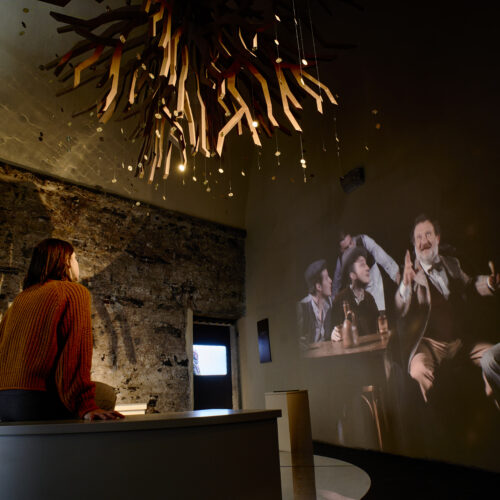
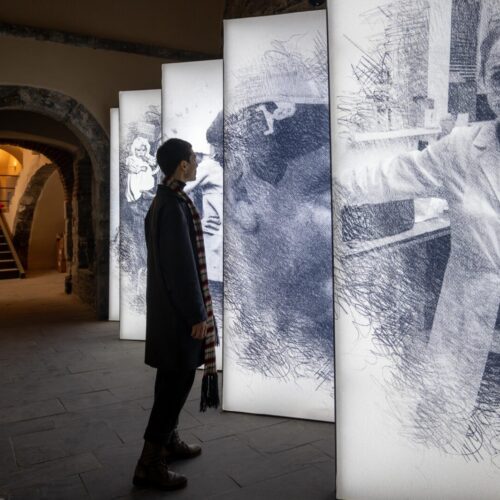
Ground floor
Area A04 –The health of Italians
A large zenithally projected table depicts the poor surroundings of the time. In the background, a rear projection screen shows a woman moving around in a peasant kitchen. The visitor can sit at the table and watch the plates being filled and emptied. The table houses 6 interactive stations: by placing your passport on the NFC sensor of the stations, you can access specific information on eating habits and issues of the past. Two large touch screens on the wall show two young farmers, a man and a woman. There are points of interest on different parts of the body: by touching these points, symptoms – the main quality-of-life issues – and related diagnoses appear.
Area A05 – Crops and migration
The overall picture on health and nutrition ends with a visit to the garden, where the most common odorous essences used in Italian cuisine are on display.
Area A06 – Myths, dreams and propaganda
The setting up of the small vaulted room is entrusted to two scenographic elements and a video projection. A wall projection depicts the ambience of the tavern and the arrival of the emigrant returned from America. A second projection runs the related images, as if they were projections of the imaginary, on the walls, ceiling and, thanks to a reflecting platform, floor.
Area A06 – Travelling by land/travelling by sea
In the passageway to the staircase, the dividing partition wall with the entrance hall reproduces a railway carriage with three monitors. Six characters of different ages are visible through the windows, waiting. Next to this, a reproduction of the cross-section of the ship Julius Caesar shows, by means of a monitor, the activities in the pivotal places of the ship.
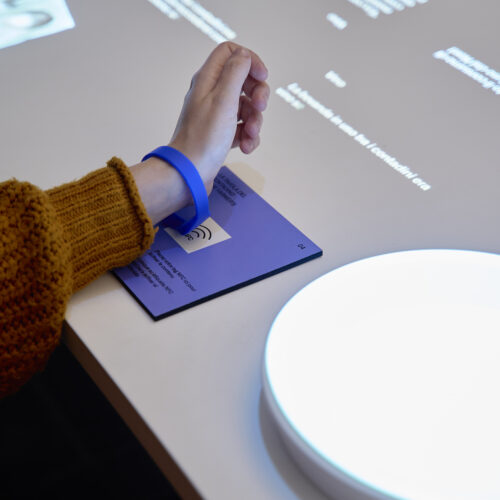

First floor
Area A07 – Destination World
A system of two organically shaped wooden tables recalls and contains, embossed in relief, the design of the entire planisphere. Exploiting the suggestion of georeferencing the site Diaries tell the story (MAECI-Archivio Diaristico Nazional), it is possible to interact with the map and browse through stories and archive films. Interactive sections consist of recessed monitors masked from the floor, where visitors answer questions about migration flows.
Area A08–Italians on the move
In the outdoor gallery, silhouettes belonging to different categories of migrants appear on the first floor loggia. Using motion sensors, an audio effect is activated and plays their stories. In the centre of the gallery, two fixed stations allow the different phenomena to be summarised and the stories to be heard more fully.
Area A09 – Migration and politics
An immersive installation with a 360° projection system presents the political debate on migration. The visitor is at the centre of the event and is asked to listen to the speech or rally of the politician on duty, surrounded by images and documents.
Area 10 – Memorial
A large planisphere is suspended from a trellis anchored to the perimeter walls of the small courtyard. Steel cables, symbolically restoring meridians and parallels, identify coordinates and support a metal mesh fabric in the shape of continents. A red rope is suspended from each of the knots, to which a metal element is attached that reproduces the name of the identified place. On the visitor’s head weighs a number of knots proportional to that of the victims of the tragedies.
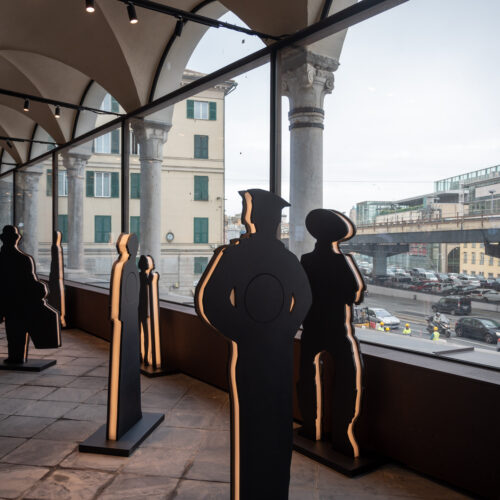

Second floor
The visitor encounters a kind of vertical labyrinth in which he will feel lost and disoriented. Accessing different spaces and contents, it is questioned by various character-types that the migrant encounters on arrival in the new country: immigration officer, possible employer, landlady, policeman, trade unionist. Climbing between the volumes, you access cubes at higher levels and approach the roots fixed to the top of the installation. Once at the top, it is possible to descend without using the stairs, but by using a chute that crosses the set of cubes. The installation is fully accessible, thanks to the inclusion of two elevators.
Area A12 – Work, work, work
The installation occupies the entire room, taking great care to leave both the wall frescoes on the west side and the decorated portion of the wooden ceiling usable. The section is set up with an installation of beams and girders, symbolising the central role of emigrants in the construction industry: a mirrored floor and ceiling help reproduce the feeling of vertigo and disorientation of the emigrant worker. Two monitors show archive footage. On the east wall, a large lightbox presents the iconic image Lunch at the top of a skyscraper. An interactive station dialogues with the passport and, based on the data, assigns an occupation to the visitor, giving information about work.
Area 14 – Emigration: Rights, duties and freedoms
Aspects of family life are shown on two projections on the walls that reconstruct an interior of a home-atelier.
The Little Italy-style setting is summarised by two key elements: the lamppost and the bench. Extra-long monitors reproduce two actors in full-scale dialogue. A silhouette depicts the skyline of the various cities featured in the narrative. Further on, the room reproduces a typical early 20th century New York diner: at the end of the room is the bar ‘counter’ and behind the counter a recessed vertical monitor shows a bartender intent on washing glasses. At the touch of a passport, the video activates and the bartender begins to narrate. On one side of the room, a projection of a procession appears with signs of insults and aggressive demonstrators towards the bartender and his patrons. A touch screen allows visitors to explore the lives of famous Italians abroad, while a second box offers a quiz: visitors will have to recognise the Italians from the projected photos.
Ground floor
A large central projection on the apse marks the overall space, addressing the themes of internal and contemporary emigration. Several rotating totems, equipped with LED monitors, allow visitors to explore and modify the geometry of the room. Two totems allow visitors to compose their own personal postcard by choosing images and words. A large final projection shows a cloud of words reflecting the choices of all visitors. In continuity with the entrance space is a system of mechanised tracks that allow the movement of bird silhouettes, symbolising the natural condition of migration. Finally, it is possible to consult the CISEI stations, where one can search by name for ancestors who participated in a migration story.
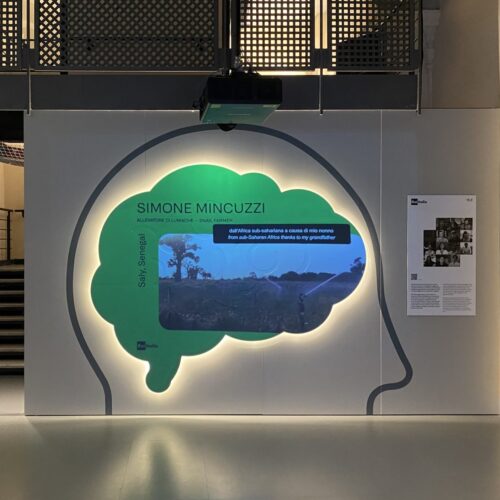
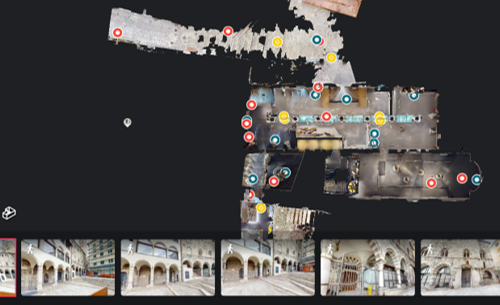
Virtual Tour
It is possible to virtually visit the MEI spaces by choosing between two thematic routes. The first is dedicated to the medieval building that houses the museum, the Commenda di Pré, and its history and architecture. The second is dedicated to the National Museum of Italian Emigration, with access to all the exhibition rooms and courtyards.
Sport in the World
The exhibition area dedicated to sport starts on the first floor of the exhibition where, in the planisphere of the ‘Destination World’ section drawn on the wooden tables, another 12 stories related to the world of sport have been included, in addition to those already told.The sports story then continues in the touch station on the ground floor, together with the large projection that mixes video footage and photographic images.
”A space for reflection along a multimedia and interactive path - not a display case, not an exhibited object: life stories handed down from biographies, letters, diaries and told through digitised images or interpreted by actors - distributed over the three floors of the Commenda di San Giovanni di Pré.
Antonio BarillàLa Stampa
